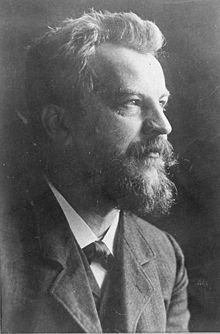Franz Studniczka
Franz Studniczka (born August 14, 1860 in Jaslo , Galicia , † December 4, 1929 in Leipzig ) was an Austrian classical archaeologist and from 1896 to 1929 professor of classical archeology at the University of Leipzig .
Life
Franz Studniczka was born in 1860 as the son of an Austrian civil servant. He studied Classical Archeology and Ancient History in Vienna and received his doctorate in 1882 under Otto Benndorf . He then worked as an assistant in Vienna and completed his habilitation in 1887 with a thesis on archaic painting. In 1887 he became assistant curator of the collection of coins and antiquities of the imperial family in Vienna as well as a private lecturer at the University of Vienna, until in 1889 he accepted a professorship for Classical Archeology at the University of Freiburg im Breisgau . Finally, in 1896, he succeeded Johannes Overbeck, who died in 1895, at the University of Leipzig . He held this professorship until his death, his successor being Herbert Koch .
Studniczka was a full member of the German Archaeological Institute and the Saxon Academy of Sciences in Leipzig (1896), a corresponding member of the Prussian Academy of Sciences (1924) and an honorary member of the Society for the Promotion of Hellenic Studies .
meaning
Studniczka was a connoisseur of Roman and Greek art of the very first order. His style-critical methods in archeology, including Menander, were milestones in archaeological research and are still considered pioneering today. His methods proved to be an important aid not only in the critical analysis of style, but also in the detection of forgeries . In 1911 Studniczka wrote the first careful analysis of a relief in the Museum of Fine Arts, Boston , the Boston Throne , in which he recognized a counterpart to the better-known Ludovisian throne and postulated its authenticity - which is still not undisputed today. Studniczka's restoration of the Copenhagen Artemis Iphigenie group in the Ny Carlsberg Glyptotek is one of the most outstanding achievements in Leipzig archeology.
The University of Leipzig owes Studniczka the further expansion of the collection of antiquities started under Overbeck, especially of casts, making it one of the largest cast collections in Germany. Under his directorate, the holdings of antique originals in the University's Antique Museum were significantly expanded. This was achieved by winning numerous sponsors. The American Edward Perry Warren in Boston and the Englishman John Marshall in Oxford deserve special mention.
Fonts (selection)
- Contributions to the history of the ancient Greek costume. In: Treatise of the archaeological-epigraphic seminar in Vienna 1886 (= dissertation).
- Cyrene, an ancient Greek goddess. 1890.
- Kalamis. A contribution to Greek art history. Leipzig 1907.
- The portrait of Aristotle. A. Edelmann, Leipzig 1908.
- The portrait of Aristotle . Leipzig 1908.
- The counterpart of the Ludovisian throne. In: Yearbook of the German Archaeological Institute . Volume 26, 1911, p. 50 ff.
- The symposium of Ptolemy II. According to the description of Callixeinos. Leipzig 1914.
- The portrait of Menander. In: New Yearbooks for Classical Antiquity . Volume 21, 1918, pp. 1-31.
- The east gable group from the Temple of Zeus in Olympia. Leipzig 1923.
- The Sophocles Statues. In: Journal of Hellenic Studies . Volume 43, 1923, pp. 57-67.
- Artemis and Iphigenia. Marble group from the Ny Carlsberg Glyptothek. Leipzig 1926.
- The beginnings of Greek portrait art. In: Zeitschrift für bildende Kunst. Vol. 62, No. 6, 1928-1929, pp. 121-134.
literature
- Ludwig Curtius : Obituary for Franz Studniczka: spoken in the Winckelmann celebration of the Roman Institute in 1929. In: Communications of the German Archaeological Institute. Roman department . Volume 44, 1929, pp. I-III.
- Herbert Koch : Obituary for Franz Studniczka. In: Meeting reports of the philological-historical class at the Saxon Academy of Sciences in Leipzig. Volume 82, Issue 2, 1930, pp. 1-20 (with Studniczka's bibliography).
- Andreas Rumpf : Franz Studniczka. In: Biographisches Jahrbuch der Altertumskunde. Volume 245, 1934, pp. 51-119 (with Studniczka's bibliography).
- Robert Heidenreich : Franz Studniczka (1860–1929). In: Max Steinmetz (Ed.): Important scholars in Leipzig. For the 800th anniversary of the city of Leipzig on behalf of the Rector and Senate of the Karl Marx University. Volume 1, Leipzig 1965, pp. 133-138.
- Hartmut Döhl : Franz Studniczka 1860–1929. In: Reinhard Lullies , Wolfgang Schiering (Hrsg.): Archäologenbildnisse . Portraits and short biographies of classical archaeologists in the German language. von Zabern, Mainz 1988. 2nd edition 1991, ISBN 3-8053-0971-6 , pp. 138-139.
- Hans-Ulrich Cain : Studniczka, Franz. In: New German Biography (NDB). Volume 25, Duncker & Humblot, Berlin 2013, ISBN 978-3-428-11206-7 , pp. 621 f. ( Digitized version ).
- E. Lebensaft - Ch. Mentschl: Studniczka Franz. In: Austrian Biographical Lexicon 1815–1950 (ÖBL). Volume 13, Verlag der Österreichischen Akademie der Wissenschaften, Vienna 2007–2010, ISBN 978-3-7001-6963-5 , p. 440 f. (Direct links on p. 440 , p. 441 ).
Web links
- Literature by and about Franz Studniczka in the catalog of the German National Library
- Franz Studniczka in the professorial catalog of the University of Leipzig
- Overview of Franz Studniczka's courses at the University of Leipzig (winter semester 1896 to summer semester 1914)
- Short history of classical archeology in Leipzig with a portrait of Studniczka
Remarks
- ^ Doctoral files , archive of the University of Vienna, PH RA 243 .
- ↑ To the cast collection in Leipzig
| personal data | |
|---|---|
| SURNAME | Studniczka, Franz |
| BRIEF DESCRIPTION | Austrian classical archaeologist |
| DATE OF BIRTH | August 14, 1860 |
| PLACE OF BIRTH | Jaslo |
| DATE OF DEATH | December 4, 1929 |
| Place of death | Leipzig |


